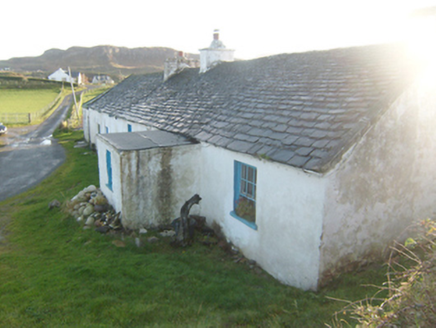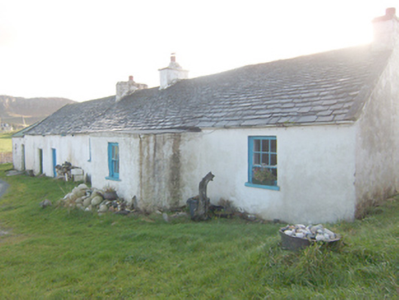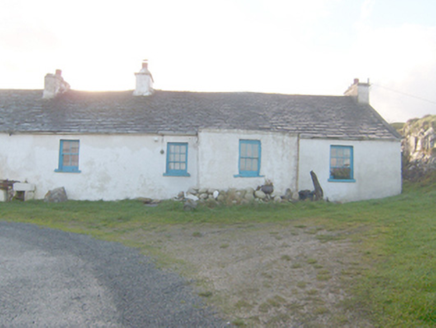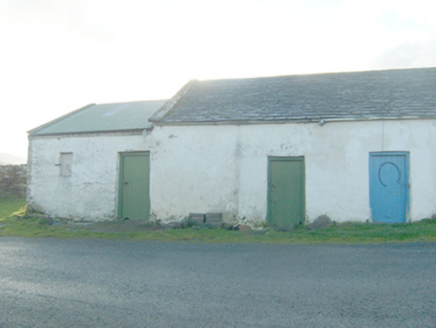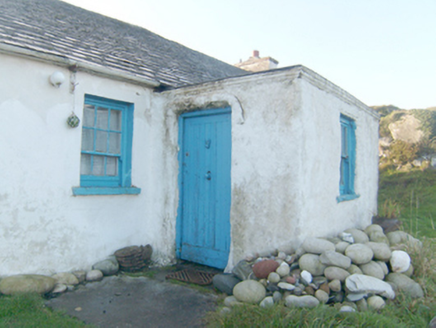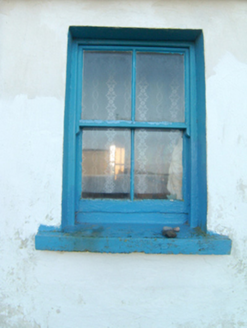Survey Data
Reg No
40901515
Rating
Regional
Categories of Special Interest
Architectural, Social, Technical
Original Use
House
In Use As
House
Date
1800 - 1840
Coordinates
199851, 435424
Date Recorded
15/11/2010
Date Updated
--/--/--
Description
Detached four-bay single-storey vernacular house, built c. 1820, having single-bay single-storey flat-roofed entrance porch added towards the north-west end of the front elevation (north-east), added c. 1900, and with two-bay single-storey outbuilding attached to south-east gable end having two-bay single-storey addition attached to the south-east, added c. 1900. Single-storey extension to the rear (south-west). Pitched Roshine slate roof to dwelling to the north-west having projecting eaves course, three rendered chimneystacks (one to either end of the dwelling, and one to the south-east end of original dwellings). Flat felt roof to porch having moulded eaves course. Smooth rendered walls. Square-headed window openings with some stone sills, and with six-over-three pane timber sliding sash windows. Square-headed window opening to the front face of porch (north-east) having two-over-two pane timber sliding sash windows. Square-headed doorway to the south-east face of porch having battened timber door. Pitched Roshine slate roof to outbuilding to the south-east having rendered verge to the south-east gable end, smooth rendered rubble stone walls, and square-headed doorways with battened timber doors; pitched corrugated-metal roof with raised rendered verge to the south-east gable end to outbuilding attached to the south-east end having smooth rendered walls, square-headed doorway with battened timber door, and with blocked square-headed window opening. Road-fronted aligned along road-alignment to minor road\laneway in the rural countryside to the south-west of Dunfanaghy. Concrete farm outbuilding and rubble stone outbuildings across road to the north-east. Interior retains original flagstone floor with suspended timber floor to later parlor\bedroom extension to the south-east.
Appraisal
An attractive and well-maintained vernacular house that retains its early form and character, and is an appealing feature in the scenic landscape to the south-west of Dunfanaghy. Its visual appeal is enhanced by the retention of much of its salient fabric including the timber sliding sash windows. Modest in scale, it exhibits the simple and functional form of vernacular building in Ireland. Of particular interest in the survival of the graded Roshine slate roof, which helps to give this building a charming picturesque appeal. Roshine slate is a locally-quarried schist that was commonly used as a roofing material, and for general construction for all aspects of construction such as walls and floors etc. in the Dunfanaghy area in the nineteenth century. The number of Roshine schist slate roofs in North Donegal and the Dunfanaghy region is steadily dropping, which makes this particular example at Corcreggan an increasingly important survival. This building is indicated on the Ordnance Survey first edition six-inch map of c. 1837; (Ordnance Survey twenty-five inch map). The porch is a later addition, perhaps added c. 1900. The location of the chimneystacks to the original three-bay dwelling to the north-west and the position of the doorway suggests that this building is of the ‘direct entry’ type that is characteristic of the vernacular tradition in north-west Ireland. The form of this building, and the location of the chimneystacks, suggests that it was extended along its length by a bay to the south-east at some stage, which is a characteristic feature of many vernacular houses that were extended as required. The attached outbuilding to the south-east also has a Roshine slate roof while the later addition to the south-east end has a corrugated-metal roof, itself a vernacular roofing material that is common in Donegal; this helps create an appealing long low composition. Then interior also survives intact with flagstone floors and boarded ceilings. This house is one of the better surviving examples of its type in the Dunfanaghy area, and is an important element of the built heritage of the county.
